Hands On with Fable: The Journey
- Updated: 19th Sep, 2012
You know those parts of the Fable RPGs where you’re walking between towns, being attacked by nameless forest dwellers and not really achieving anything? That’s basically this whole game.
I really wanted it to be good. I was very excited when the gameplay was first revealed. From the day I brought home my Kinect, I’ve wanted two things: to cast magic by waving my hands and to play with a Minority Report-like interface. 22 months later and neither of these have happened.
Fable: The Journey has you escorting immortal blind seeress Theresa on her journey back to the Spire. Along the way you meet the typically weird and wonderful dwellers of Albion, battle hobbes, fight skeletons and sling rocks at giant trolls. The villages and dungeons you’ll come across are lovely. There’s plenty of story exposited at you and it’s all supported by the environmental design. No matter how peaceful a setting appears, you’ll be quickly besieged by enemies (because there’s nothing else to do in the game). When you’re not in combat, you’ll be cantering along with your biggest choice being to drive left or right around that rock in the middle of the road.
On The Road
Driving the cart is tedious. You can flip the reins to go faster or raise your hands above your head to stop. Remember the will, strength and skill balls that you collect from corpses in the previous games? You’ll find these littered along the road. For no reason at all you need to be galloping to pick up the red balls and slowly ambling to pick up the blue ones. Green balls can be collected at any speed.
The blue balls tend to be obscuring a rock or other solid object in the road, so it makes logical sense to slow you down. It’s annoying and fiddly though, and just results in you constantly weaving back and forth, speeding up or slowing down. That’s only fun for 5 minutes. 90 minutes into a recent build and I was ready to pack it in forever. There was no sign of calling commands to your horse and the supposed empathy simply doesn’t exist.
You’re kept quite busy on your journey. Every 60 to 90 seconds you’ll come across a rest stop or a new plot point. You don’t need to drive into rest stops. Just slow down inside a twinkling circle and you’ll automatically ride in. The same goes for “interesting” stops along the way. Slow down in the circle and you’ll hop out of your cart to investigate a small copse of hobbe-filled ruins, a statue you can move to reveal a treasure chest or a babbling NPC who is nicely-written but basically a bit of filler on your journey.
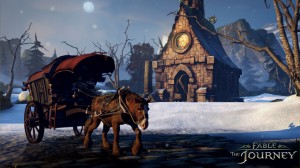 Once inside the rest stop, you’ll be presented with the healing mode to restore your horse, Seren. Kinect’s exciting new way to virtualise veterinary practices is to hover over the wound marks with your hand. Successfully hover over all the wounds on one side and your horse will turn around to present the other. Heal those and you’re free to explore.
Once inside the rest stop, you’ll be presented with the healing mode to restore your horse, Seren. Kinect’s exciting new way to virtualise veterinary practices is to hover over the wound marks with your hand. Successfully hover over all the wounds on one side and your horse will turn around to present the other. Heal those and you’re free to explore.
A rest stop is just a series of items to waggle your hands at. You don’t actually walk around or look at things. Instead, you lean to the right or left and the camera slowly drifts around to the next point of interest – usually a chest or a water trough. Reach out with both hands to lift the chest lid and you get a card which might do something exciting like unlock Theresa for Fable Heroes. Or it might be a useless collectible. Head to the water trough and you can pretend to pump water in exchange for XP. Whee!
If you’re really lucky, you can stretch your hand up to an apple tree and then out hold out a virtual apple for Seren to eat. This doesn’t actually benefit Seren, as far as I can tell, but you get another tiny XP bump.
Don’t forget to clean your poor horse as well. Rather like a Kinect version of Nintendogs, you can rub your hands all over your horse to brush away the dirt. Unlike Nintendogs, you’re not rewarded with a charming animation of your horse enjoying the scrubbing. Lionhead had such great history of doing this, with the Black & White creatures. It makes me sad that Seren doesn’t react at all.
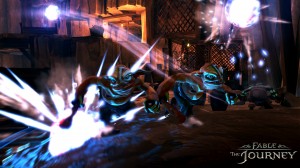
In Combat
Fable: The Journey does let you cast magic but in a very rudimentary way. Thanks to a pair of magic gauntlets familiar to anyone who knows the Fable series, combat mode allows you to wield a variety of powers. You left hand can grab and push things from a distance. Your right hand will gain a few options over the course of the game, starting with a basic shock power.
The demo that went up on Xbox Live this week is shorter and more combat-oriented than the build I’ve been playing. It has no horse-steering and will give you access to three different magical attacks.
All credit to Lionhead, aiming with Kinect is pretty good when it’s properly calibrated. To fire off the standard bolt attack, you raise your hand to your shoulder to power it up, then thrust forwards at your target. There’s a detectable drift-to-target bias but you do have to put some effort into aiming. You also have an aftertouch mode – throw your bolt into the air and then drag your arm down to shower multiple targets with damaging magic.
To use the shard attack, you raise your hand to your shoulder, hold it slightly behind your ear as if you’re holding a javelin, and thrust forwards at your target. For the fireball, raise your hand to your shoulder, wave it around and then thrust forwards at your target.
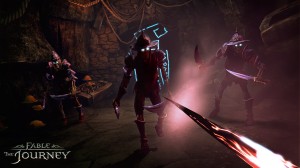 All sounds a bit samey? It is. Kinect has all sorts of trouble telling the moves apart, so you can be flapping away to create a fireball and end up with the spear instead. It’s immensely frustrating that they chose such a simplistic model. You can also change attack types by saying “Fireball” or “Magic Shard”. This worked about 30% of the time for me.
All sounds a bit samey? It is. Kinect has all sorts of trouble telling the moves apart, so you can be flapping away to create a fireball and end up with the spear instead. It’s immensely frustrating that they chose such a simplistic model. You can also change attack types by saying “Fireball” or “Magic Shard”. This worked about 30% of the time for me.
Many the combat scenes are designed to force you into using both hands. One section had me on the cart fighting shielded hobbes that were riding massive beasts in front. The obvious, and only, solution was to use my left hand to unbalance the hobbes and follow up with an attack from the right hand. Annoyingly, most combat situations suffer from this restriction – there’s only one “right” way to kill things.
Battling hobbes in a village needs you to drag them out of cover and hit them with magic. You can toss them into the air and hit them with a bolt but the combo doesn’t seem to give much of a damage bonus. When fighting the Hollow Men you can pull off heads and limbs but not drag them into each other or hit one Hollow Man with another’s stolen shield.
Pull a hobbe that’s on a bridge and they’ll fall into the water. Toss them into the air and they’ll fall into the water. Set them on fire and they’ll more than likely fall into the water. Throwing a magical shard only made it harder to hit my target, yet sometimes I could only damage things with the shard. Yes, this is mechanically the same as using a different weapon with the same button but the whole draw of Kinect is supposed to be that it’s more fun to play with motion. Damage types are meaningless when all I’m doing is thrusting out my arms.
Fireballs can set off explosive barrels. So can pulling them over or throwing the bolt at them. I do enjoy the environmental touches but there’s not a lot of variation. I often found it more effective to just flap my hands at the screen than to try any sophisticated combinations.
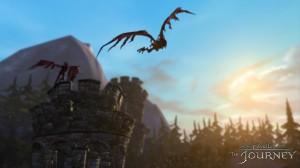 You need to sit up straight to play Fable: The Journey and it gets tiring fairly quickly. Slump back during a cutscene and Kinect might lose you. When it finds you again, you’ll more than likely need to recalibrate. This is more a flaw with the system than the game, but it all goes towards an less-than-pleasant experience.
You need to sit up straight to play Fable: The Journey and it gets tiring fairly quickly. Slump back during a cutscene and Kinect might lose you. When it finds you again, you’ll more than likely need to recalibrate. This is more a flaw with the system than the game, but it all goes towards an less-than-pleasant experience.
Fable: The Journey does a lot of things. It’s filled to the brim with interesting and adventurous ideas but there’s not enough depth for it to stay enjoyable. Albion is fascinating, as always. The characters are great but the whole experience is based on the idea that pretend motions are inherently fun. They’re are, but only for a short while. After that you need some sense of skill or accomplishment and this game provides neither.
Fable: The Journey will be released for Xbox 360 Kinect on 12th October 2012.

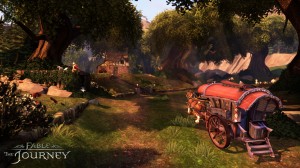
2 Comments